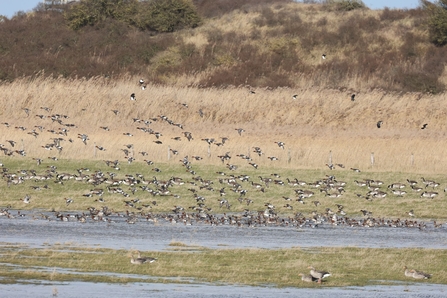The year got off to a fine start with a bittern on the 1st at Chapel Pit and remained at this location daily until 19th Jan. It left the area after a cold spell that froze the pit for a couple of days. It is very encouraging that bittern sightings are becoming more frequent in recent years. At the same time a couple of female goosander were also present and feeding well alongside the bittern. This shows that the pit is well stocked with suitable prey items. In the future we are hoping to acquire some funding to do a detailed fish survey throughout the Lincolnshire Coastal Country Park. Huttoft Pit is interesting in that years ago it did sustain good numbers of diving (fishing) ducks and regular bitterns on a regular basis. It can only be assumed that the prey that was once here is no longer present.
Lincolnshire Coastal Country Park - January 2022
Large flock of pink-footed geese coming in to roost at Anderby Marsh © Garry Wright

A bittern was on Chapel Pit for almost three weeks in January (Garry Wright)
A jack snipe showed very well at Huttoft Pit for several days in early January just in front of the hide. It is always a treat to see such an elusive species at such close range. When feeding they have a very distinctive bouncing action.

Jack snipe showed very well at Huttoft Pit (Garry Wright)
At least four bearded tit were recorded almost daily, it is hoped that they may stay to breed, having never stayed this long before over the winter months. A brambling flew over the reserve on the 25th.
Anderby Marsh is certainly exceeding expectations with water levels at an all-time high, providing refuge and feeding opportunities for over 3,000 water birds! The local pink-footed goose flock (numbering 2,000 birds) is now using the marsh as a roosting site which has never happened before. Other species using the marsh include four little egret, 390 wigeon, 140 teal, two shoveler, 72 gadwall, 450 lapwing, 108 golden plover, 46 curlew, 18 dunlin, four black-tailed godwit, six redshank and 15 snipe. Marsh harrier, buzzard and peregrine falcon are now starting to take full advantage of this all you can eat buffet with some spectacular hunting behaviour observed.

Wigeon were present in good numbers on Anderby Marsh (Garry Wright)
Seawatching highlights in January included: long-tailed duck on the 1st, three velvet scoter on 14th, numerous black-throated diver and great northern diver, several records of shag, 106 kittiwake on 20th, purple sandpiper on 29th, adult Mediterranean gull and 111 kittiwake on 31st.
Short-eared owls continue to perform very well over the Sandilands Golf Course in the evenings with sightings of 1-2 birds daily. They are often joined by a barn owl which also favour the rough grassland habitat for hunting.
A group of seven white-fronted goose have been seen in amongst the local pink-footed goose flock. Numbers of pink-footed goose appear to have reached a record peak of 2,000; typically wintering numbers in the area usually peak around the 300 mark. They can be regularly seen feeding on arable land around Huttoft Pit and Wolla Bank.
A single chiffchaff has been wintering around Chapel Six Marshes for most of the month. The increasingly warmer winters have resulted in more chiffchaffs staying in the UK in recent years; rather than migrating to the warmer continent.
The group of five grey partridge continue to show well around Marsh Yard feeding at close range from the entrance road.
Non-avian highlights
Sightings of brown hare continue to increase in the warmer weather. Warm days in February should see some boxing behaviour.
A harbour porpoise was seen from Chapel Observatory on the 21st. Porpoise sightings are generally very low in the winter months. Grey seals are seen regularly along the coast.
One real surprise in January was the emergence of elder leaves at Chapel Pit! This species generally does not start to leaf until April so this was much unexpected.
Roe deer and muntjac deer have been showing very well in recent weeks with sightings of multiple animals. It is not unusual to spot both of these species regularly while driving along the coast road at dusk.
Five species to look for in February
Brown hare – look out for these impressive mammals boxing on fine days on farmland throughout.
Short-eared owl – spend an evening owl watching around Sandilands Golf Course. There is surely no better way of spending a winters evening than watching hunting owls. If you are lucky you may also spot a barn owl.
Pink-footed geese – look out for this species around Anderby Marsh and listen out for their musical calls. A real highlight of winter. Birds will start to return to breeding grounds in Iceland by late February.
Bearded tit – listen out for bearded tits calling at Huttoft Pit. Their distinctive ‘ping ping’ calls can carry a surprisingly long way.
Avocet – previously a scarce bird in the Lincolnshire Coastal Country Park, however, the marsh at Anderby is now very favourable for this species. Hopefully a few birds will stay and breed in 2022.

